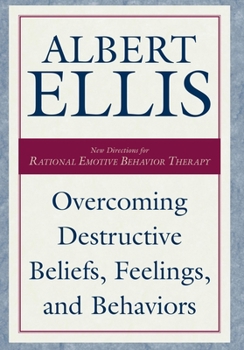Overcoming Destructive Beliefs, Feelings, and Behaviors
Select Format
Select Condition 
Book Overview
First developed in 1955, Rational Emotive Behavior Therapy (REBT) is the original form of Cognitive Behavior Therapy and one of the most successful psychotherapeutic techniques in the world. Its founder, world-renowned psychologist Albert Ellis, now offers an up-to-date description of the main principles and practices of this innovative and influential therapy.REBT emphasizes the importance of cognition in psychological disturbances. Its aim is to...
Format:Hardcover
Language:English
ISBN:1573928798
ISBN13:9781573928793
Release Date:November 2001
Publisher:Prometheus Books
Length:424 Pages
Weight:1.60 lbs.
Dimensions:1.3" x 6.2" x 9.0"
Customer Reviews
5 ratings
Excelent
Published by Thriftbooks.com User , 13 years ago
It is the last information of that therapy. It was really usefull for my courses in the University.
Great Book!
Published by Thriftbooks.com User , 16 years ago
This book is great for counselors or for people who want to learn more between rational and irrational thoughts. Thanks!
Change Destructive Beliefs to Heal and Reclaim Happiness
Published by Thriftbooks.com User , 20 years ago
Albert Ellis wrote a goldmine of a book to help people and therapists heal those who are in pain with destructive beliefs, post traumatic stress disorder, anxiety, marriage and family, jealousy, OCD, and many other difficulties that CAN be healed. It requires commitment and dedication on the part of the individual to want to heal. One of the key points in this book is that our unhappiness stems from irrational beliefs, "must", "should" and how important it is to "create a vital meaning and absorbing interest in your life..." This book will be outstanding for anyone committed to his or her own self growth, healing, with the strong desire to turn it all around. Highly recommended! Barbara Rose, Ph.D. author of Stop Being the String Along: A Relationship Guide to Being THE ONE and If God Was Like Man Editor, inspire! magazine
Most up-to-date description of REBT
Published by Thriftbooks.com User , 22 years ago
This book contains the most up-to-date description of Rational Emotive Behavior Therapy available. Ellis especially emphasizes the following:* The use of action verbs (e.g. I make myself angry or depressed) instead of nouns (I suffer from depression). This continually reminds oneself of the principle of emotional responsibility: neurotic difficulties don't come out of the blue, I partly create them by my irrational beliefs* The basic philosphical underpinnings of REBT and how REBT relates to other systems of therapy, e.g. systems therapy, (cognitive) behavior therapy and psychoanalysis* The flexible use of therapeutic procedures, sometimes even non-REBT techniques, to help patients overcome their neuroticizing* As usual, Ellis tries to help the reader to achieve unconditional self-acceptance, unconditional other-acceptance and high frustration tolerance* In contrast to some earlier books, Ellis does not postulate to have a panacea for all psychological problemsAt times repetitive, this book nonetheless is worth reading as it contains several so far underestimated aspects of REBT. I recommend it for therapists and people already familiar with the basics of REBT. The interested lay person should better read Ellis' book: Ellis, A. (2011). Feeling better, getting better, staying better.
full of insight
Published by Thriftbooks.com User , 22 years ago
This new book by Albert Ellis, founder of Rational Emotive Behavior Therapy (REBT), is a collection of articles he published in the last several years, some of them partly rewritten. Ellis originated REBT in 1955. Since then, it has gained great influence, primarily in therapy, but also in management coaching and training. The basics of REBT have remained the same. They revolve around the ABCs of self-disturbing. (A) stands for the Adversities we encounter, (B) for our Beliefs about these Adversities, and (C) for the emotional and behavioral Consequences of these Beliefs. A coach, therapist, or trainer using REBT, has two goals: 1) to help people feel better and 2) to make them function better and does so by helping to replace the problematic Beliefs by more usable and realistic Beliefs. Although the core of REBT has remained the same, some aspects of the approach have kept on evolving, and Ellis keeps on leading the development of REBT himself. The book shows many examples. Important is for instance that Ellis now defines the (B) of the ABCs not merely as Believing but as Believing-Emoting-Behaving. Very interesting is how Ellis uses action language when writing about emotional problems. He thinks we misuse many nouns in psychology instead of verbs and therby create "semifictional entities" or "thought things". An example: Ellis doesn't say: "I suffer from depression" but "I depress (myself)". A terrific chapter I found the one about postmodernism and constructivism in psychotherapy. I have never read such a clarifying chapter about this intruiging subject before. Ellis convincingly demonstrates how REBT and constructivism are not at odds but conincide well with each other. To illustrate, he says: "You have considerable power to construct self-helping thoughts, feelings, and actions as well as to construct self defeating behaviors." Although this book is NOT intended to be a self-help book, each chapter ends with some great self-help suggestions, which can also be read as chapter summaries. This book, which is filled with great insights, shows the great inspiraton of Ellis, which is still there.




